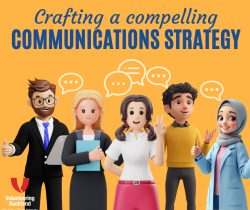Unlocking Sustainability: Crafting a Compelling Internal Communication Strategy on Volunteering

In the nonprofit sector, volunteers are not just a resource—they are often the lifeblood of the organisation. Their contributions extend far beyond hours logged; they bring passion, local knowledge, and community credibility. Yet, despite this, the true impact of volunteering is often under-communicated within charities, especially to decision-makers and supporters who hold the purse strings or shape strategic direction.
To ensure long-term sustainability, it’s crucial to develop a creative and compelling internal communication strategy that demonstrates the value of volunteering—not just to celebrate contributions, but to secure ongoing support, funding, and structural commitment. This means moving beyond thank-you notes and into a realm where data, storytelling, and strategic alignment meet.
Why Internal Communication on Volunteering Matters
For many Boards and senior leaders, decisions about funding, staffing, and programme priorities are made based on measurable impact, alignment with strategic goals, and long-term sustainability. Without a clear internal narrative around the impact of volunteering, it becomes easy to deprioritise resourcing volunteer programmes in favour of seemingly more “tangible” areas.
An effective internal communication strategy can:
- Educate leadership on the scope and scale of volunteer contributions.
- Demonstrate alignment between volunteering and the organisation’s mission and outcomes.
- Secure resources by building the case for investment in volunteer management infrastructure.
- Build organisational culture that values and leverages community engagement.
Key Elements of a Compelling Strategy
1. Clarify the Strategic Value of Volunteering
Start by mapping how volunteers contribute to organisational goals. Are they helping deliver core services? Extending reach into communities that paid staff can’t? Enhancing the organisation’s visibility or credibility? These strategic links must be made explicit.
Create clear internal messaging that connects volunteer contributions to key performance indicators (KPIs), funding outcomes, and community impact. For example: “Volunteers enabled the organisation to reach 40% more clients this year without increasing operational costs.”
2. Use Storytelling with Data
People are moved by stories, but convinced by numbers. A powerful internal communications approach pairs the two.
Use volunteer data creatively:
- Report on volunteer hours, retention rates, training uptake.
- Calculate the economic value of volunteering using credible models (e.g. replacement cost or social return on investment).
- Combine this with impact stories—short case studies or testimonials from volunteers, clients, and programme managers—to bring the data to life.
Present these in formats tailored to your audience—board reports, infographics, dashboards, or brief impact videos.
3. Ensure Leadership Visibility and Buy-in
One of the most effective communication tools is visible support from leadership. Encourage board members and executives to attend volunteer events, speak at appreciation functions, or even volunteer themselves.
Internal newsletters, intranet updates, and strategy documents should reflect leadership’s endorsement of volunteer engagement. Their voices can champion the value of volunteering to both internal and external stakeholders.
4. Align with Organisational Planning Cycles
Timing is key. Integrate volunteer-related messaging into annual reports, strategic planning sessions, and budgeting processes. Make sure the value of the volunteer programme is communicated when decisions are being made.
This might include:
- Submitting a quarterly volunteer impact snapshot for board meetings.
- Including a dedicated volunteer outcomes section in annual reviews.
- Advocating for volunteer programme funding during budget deliberations.
5. Elevate the Role of the Volunteer Manager
Often, the people managing volunteer programmes are seen as operational rather than strategic. Use internal communications to reposition volunteer leadership as a key function.
Highlight their expertise in recruitment, retention, safeguarding, and community engagement. Position the volunteer manager as a knowledge-holder whose input informs strategic decisions about outreach, partnerships, and service delivery.
6. Build Two-Way Communication Channels
Encourage feedback from volunteers and staff about how volunteer programmes are working. Regular pulse checks or surveys can provide useful insights—and demonstrate a culture of continuous improvement.
Share these findings with senior leaders. Showing responsiveness to feedback reinforces professionalism, accountability, and a commitment to best practice—all qualities Boards and funders look for.
Being Creative with Delivery
Being creative with delivery means finding fresh, engaging ways to communicate the value of volunteering that resonate with different internal audiences. Instead of relying solely on reports or emails, consider multimedia and experiential formats.
A short, engaging video with real volunteer voices can convey impact in a dynamic way, while interactive dashboards or infographics can make data more digestible. Install a “volunteer impact wall” in the office featuring stories, photos, and milestones, or incorporate storytelling into regular staff and board meetings with a rotating “Volunteer Impact Minute.” Host internal events like a “Volunteer Week Showcase” where teams can see firsthand how volunteer involvement is making a difference.
These creative approaches help make the volunteer story more visible, memorable, and emotionally resonant, encouraging deeper support from leadership and staff alike.
Consider:
- A short, animated video showing how volunteers create impact.
- A “volunteer dashboard” in the office or intranet updated monthly.
- Storyboards or photo displays at AGMs or staff meetings.
- A volunteer “impact week” with events and social media tie-ins.
- Brief “Impact Minutes” at board meetings where a story or stat is shared.
Creativity in communication keeps the message fresh and engaging, especially for audiences who are time-poor.
The Bottom Line: It’s About Sustainability
A well-resourced, well-communicated volunteer programme is not a “nice to have”—it’s a cornerstone of sustainability. When internal stakeholders understand and appreciate this, they are more likely to commit funding, time, and strategic energy toward strengthening it.
Boards and senior leaders need to see that investing in volunteer infrastructure—training, management, tools, and systems—is an investment in organisational resilience and community trust.
By embedding the value of volunteering into the heart of internal communication, organisations can move from gratitude to strategy—ensuring that the volunteer-involving programme is not only appreciated, but sustained for the long haul.

